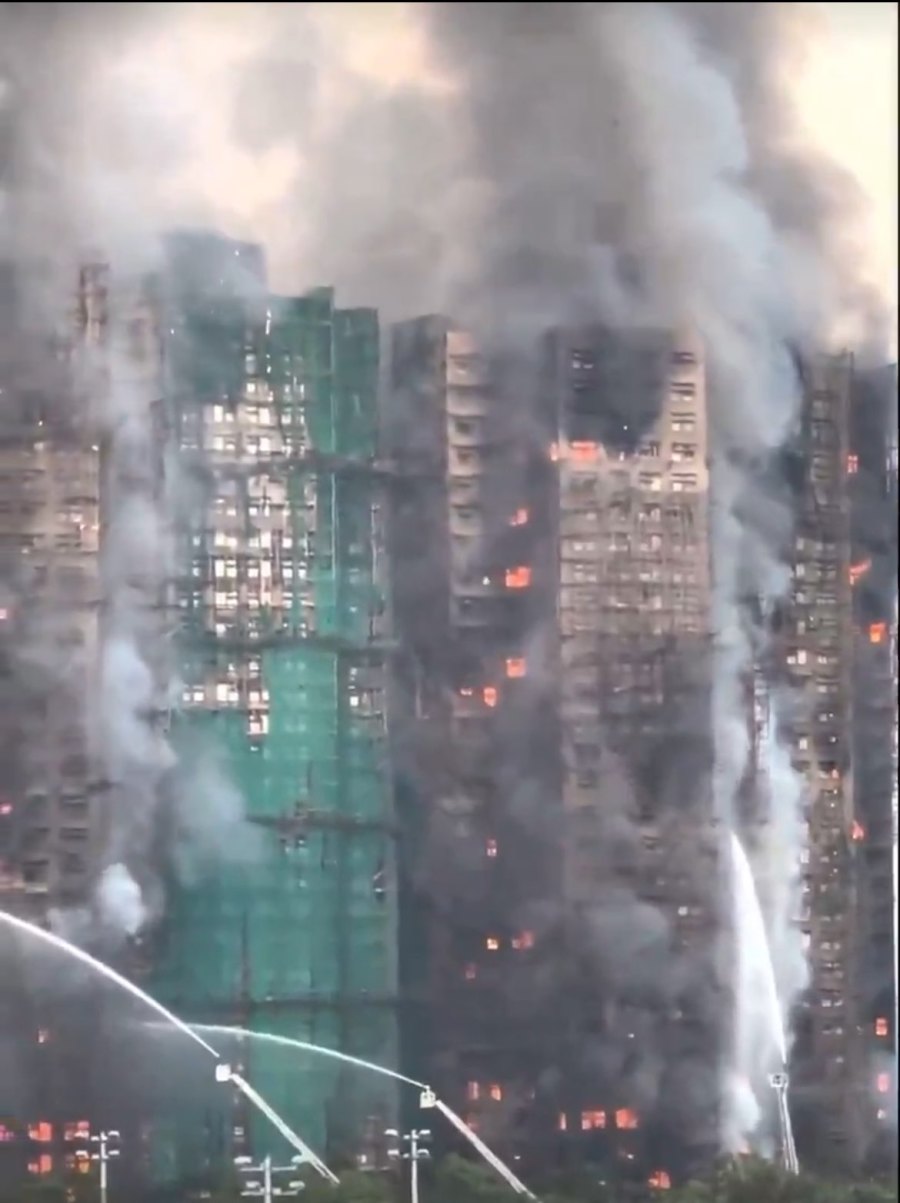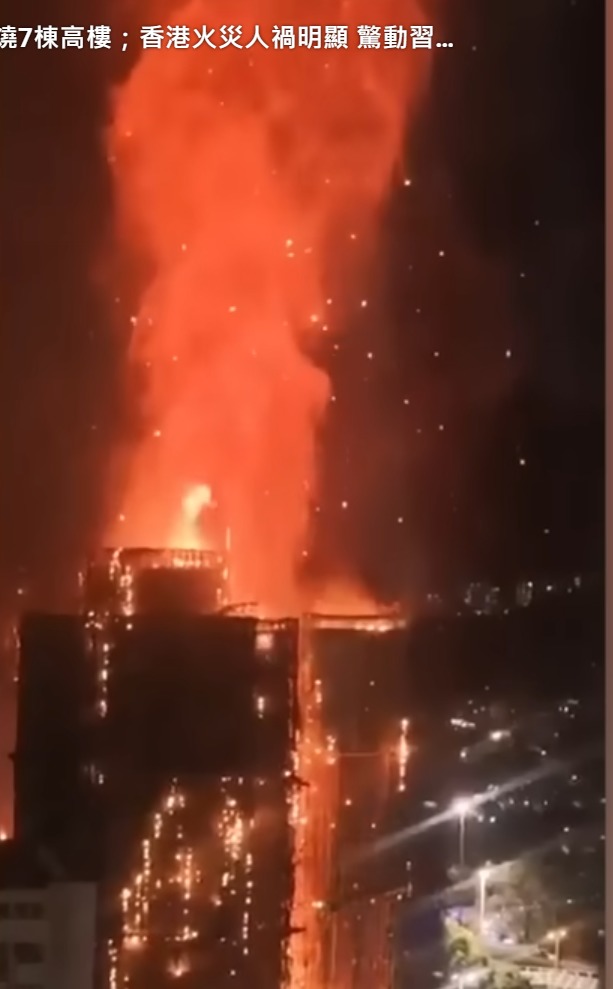As of the evening of November 27, the fire at Hong Fuk Court in Tai Po, New Territories, Hong Kong, has resulted in 44 fatalities and 58 injuries. (Video screenshot)
[People News] At 2:51 PM on November 26, a significant fire broke out at Hong Fuk Court, quickly spreading to seven residential buildings. By 6:22 PM, the situation escalated to a level five fire alarm. As of the evening of November 27, this incident has become the most severe residential fire in Hong Kong in recent years, leading to 44 deaths, 58 injuries (including 15 in critical condition and 23 seriously injured), and 279 individuals reported missing. The Hong Kong police have arrested three individuals associated with the contractors and noted two key points that are 'extremely unusual,' indicating that the investigation will take a criminal direction.
It is reported that Hong Fuk Court has been a prominent community housing estate for over 42 years. However, on the afternoon of the 26th, a sudden fire erupted, rapidly engulfing seven buildings. The fire continued to burn from the 26th into the early morning of the 27th, making it difficult to extinguish and resulting in the tragic death of a firefighter.
According to Hong Kong media outlet Hong Kong 01, prior to the fire, Hong Fuk Court was undergoing exterior wall repairs, with all buildings covered in bamboo scaffolding to facilitate the work. The fire reportedly started from the scaffolding netting on the exterior wall of Hong Cheung House, spreading upwards and subsequently affecting several nearby buildings.
The Hong Kong Fire Services Department's preliminary assessment suggests that 'multiple items and bamboo scaffolding were ignited, and due to the wind, the flames spread to nearby buildings,' causing the fire to rapidly engulf seven buildings in a short time.
During their investigation, the Hong Kong police uncovered alarming hidden details and highlighted two critical points. First, the fire initially erupted from the scaffolding on the outer wall. However, it raises concerns that the plastic sheeting and waterproof fabric used on the outer wall exhibited extremely high combustibility, suggesting they may not have complied with fire safety standards.
Secondly, even more shocking is that within the building, which was unaffected by the fire, some ventilation openings were sealed with polystyrene boards. Polystyrene is known to melt and ignite easily when exposed to heat, potentially accelerating the spread of flames, which raises doubts about the adherence to construction safety standards.
Senior Superintendent Chung Lai-yi of the New Territories North Regional Crime Unit remarked that foam materials are highly flammable and could have played a significant role in the rapid spread of the fire. It cannot be ruled out that these materials were a key factor in the swift escalation of the incident. These non-compliant materials burn rapidly at high temperatures and release toxic gases, becoming an 'invisible killer' that endangers lives.
In the early hours of November 27, the Hong Kong police arrested three men on suspicion of manslaughter; they are the heads of the construction company responsible for the maintenance work at Hong Fu Court.
The arrested individuals include 68-year-old company director Zhang ××, 58-year-old company director Li ××, and 52-year-old engineering consultant Chen ××.
The police indicated that there is ample reason to believe that the responsible parties exhibited gross negligence, which led to this incident and caused the fire to spread rapidly and uncontrollably, resulting in significant casualties.
Experts have stated that the absence of fire-retardant netting in the construction area was a key factor in the fire's spread.
According to reports from Mirror Weekly, Li Guangsheng, the president of the Hong Kong Safety Practitioners Association, highlighted that many areas have opted not to use flame-retardant nets in order to cut costs. The fire's origin may be linked to the significant amount of debris present at the construction site and sparks generated from welding activities. The incident occurred in a residential area, where many residents opened their windows, allowing flames to travel along the nets and ignite furniture and clothing inside their homes, resulting in the rapid spread of the fire.
Based on videos and images circulating on social media, Li Guangsheng believes that the nets used in the construction area lacked flame-retardant materials. Given that flame-retardant nets are twice as expensive as standard nets, many construction sites have chosen not to use them to save money. Regarding the toxicity of the thick smoke produced by the burning nets, he mentioned that it is still unclear what materials the nets are made from. If they contain polyvinyl chloride (PVC), they could emit toxic gases. 'Inhaling that thick smoke could potentially suffocate individuals or even lead to death.'
Some netizens have pointed out that the traditional use of bamboo scaffolding in Hong Kong may be a key factor in the rapid spread of the fire. Bamboo scaffolding is considered a traditional construction technique in the region, and the scaffolding industry is thriving. Compared to the metal scaffolding commonly used in Taiwan, bamboo is more cost-effective, lighter, easier to transport, and quicker to assemble.
Construction industry: It cannot be ruled out that some individuals took risks to save costs.
The guidelines from the Hong Kong Labour Department and the Buildings Department state that if scaffolding exceeds 15 meters in height, the surrounding nets must possess flame-retardant properties. He Bingde, chairman of the Hong Kong Kowloon Scaffolding Workers Union, mentioned on a radio program on November 27 that the cost of flame-retardant nets is higher than that of regular non-fireproof protective nets. It cannot be ruled out that some individuals may have taken risks to save money, and he recommended that the government enhance regulations.
He Bingde highlighted that the maintenance enclosures commonly used in Hong Kong measure 18 meters by 2 meters, with flame-retardant enclosures costing between 75 and 90 Hong Kong dollars each. In contrast, standard non-flame-retardant protective nets are priced at about 40 to 50 Hong Kong dollars, leading to a price disparity of 50% to 80%. If higher-quality flame-retardant materials are utilised, the cost can even double.
Moreover, flame-retardant nets become brittle after extended exposure to sunlight and are designed for single use, while ordinary enclosures can be reused multiple times. There is a risk that some individuals, in an effort to cut costs, may opt for non-flame-retardant nets, operating under the false assumption that 'no one will come to check.' He recommended that the government enhance regulatory measures.
He Bingde criticised the property management office or management company for allowing simultaneous construction on the eight buildings in Hongfu Court, calling this decision extremely dangerous. He argued that the work should be conducted in phases to prevent a 'chain reaction fire' scenario.
He explained that if a fire breaks out in one of the eight buildings undergoing maintenance, it could easily spread to adjacent buildings, resulting in rapid fire escalation. The maintenance work at Hongfu Court has been ongoing for over a year, leaving residents surrounded by enclosures for an extended period, which is far from ideal. He believes that the contractor and engineering consultant involved in this fire incident should bear significant responsibility.
Li Guangsheng, president of the Hong Kong Safety Practitioners Association, remarked in the same program that maintenance sites may lack safety officers for oversight and do not enforce smoking bans, with workers smoking while on the job. He characterised the situation as 'unmonitored,' clearly indicating a lack of adequate regulation from both the government and the industry.
On the X platform, users disclosed that prior to the incident, residents had lodged over 2,000 complaints with district councilors, urging the construction team not to set up scaffolding and nets too densely or thickly, and to avoid simultaneous construction on seven buildings, while also requesting fire separation measures. This issue cannot be solely attributed to Hong Kong's traditional scaffolding practices, which have been in use for a long time; problems emerged after the introduction of mainland construction units, and residents' suggestions seemed to be more professional than the actual construction methods employed.
Is a cigarette the culprit?
It is worth noting that on October 20, a local resident expressed concern in the Facebook group "Hong Fu Court Major Repair Victims Alliance" after witnessing the scaffolding fire at the Central Wah Mau Building. They reminded everyone to be particularly cautious with flammable materials. Comments from other users included, "The most important thing is for workers not to smoke while working" and "Some residents carelessly throw cigarette butts outside, which is very dangerous."
As investigations into the cause of the fire continue, some have pointed to workers who frequently smoke on construction sites and irresponsibly discard cigarette butts, with suspected footage from the scene circulating widely. While the exact cause of the incident has yet to be confirmed, many netizens have commented on the post to express their condolences, lamenting phrases like "A word becomes a prophecy," "Bless you, take care," and "Wishing everyone safety, hang in there!"
Furthermore, some users on the X platform remarked that if the Apple Daily had not been shut down, and if Hong Kong society still allowed critical voices against the government, this fire could have been prevented! Currently, senior officials in Hong Kong, in pursuit of their own promotions, and Lee Ka-chao, seeking recognition as a national leader, are neglecting the lives and deaths of the people of Hong Kong, turning the city into a stinky port. △











News magazine bootstrap themes!
I like this themes, fast loading and look profesional
Thank you Carlos!
You're welcome!
Please support me with give positive rating!
Yes Sure!